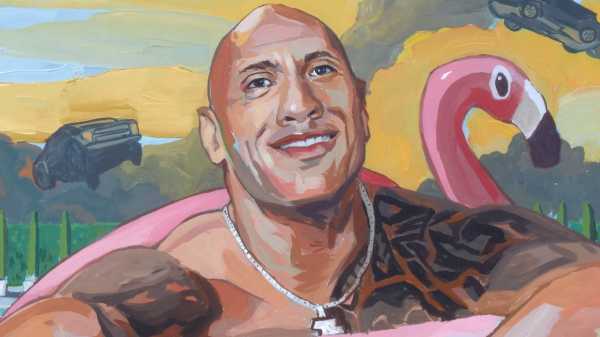
In 1996, a twenty-four-year-old Dwayne Johnson made his début in the World Wrestling Federation as Rocky Maivia, sporting cornflower-blue trunks and a thirsty white smile. The event was the annual Survivor Series, a winner-take-all group match. A big boy–six feet five and two hundred and seventy-five pounds, but nimble—Johnson was there to hit the big time, and he beat out the competition as though it were predestined, which, of course, it was. Professional wrestling is not a race but a pageant, and fans’ sympathies factor into the spectacle. Though they cheered for Rocky that first day, his greenhorn charm wore off fast. It was the nineties, the dawn of the W.W.F.’s so-termed Attitude Era. The people wanted a dose of anti-establishmentarianism with their ass-whipping, and already characters such as Stone Cold Steve Austin were abrading themselves accordingly. There was little room for a beatific kid like Maivia, grinning come victory or loss. A keen pupil of the game, Johnson knew that an adjustment was due.
So when the federation’s front office asked if he would be interested in “turning heel,” industry parlance for flipping to the dark side, Johnson agreed—with conditions. Per management’s suggestion, Rocky Maivia would make an allegiance with the Nation of Domination, a multiracial faction within the W.W.F. whose signatures included wearing kufis and raising their fists in a militant salute. Johnson, the child of a Samoan mother and a Black father, had the skin to fit in, but he chafed at the conceit. “I wanted to be a heel in the worst way,” he would recall in his 2000 memoir, but “I wasn’t comfortable with the notion of perpetuating stereotypes.” Stepping out with his new crew for the first time, in 1997, Maivia presented himself as among but not of them, telling the crowd, “Joining the Nation wasn’t a Black thing. It wasn’t a white thing.” As his story progressed, he took from the Nation what he needed to shed Rocky Maivia and reinvent himself as the Rock, a “trail-blazin’, eyebrow-raisin’ ” cuss known for smack talk calibrated to titillate and offend. “You are all unintelligent pieces of trailer-park trash,” he spat. “Do you smell it?”
The Rock had showmanship in spades, stalking the ring in leather getups and sunnies, putting the full, flexing extension of his body to use in signature moves like the body-on-body thumping Rock Bottom. He worked the crowd real good, lending humor to the choreography and brazenly soaking up applause. His villainy made him beloved, and made his name synonymous with an era of peak popularity for professional wrestling in the U.S. The crossover appeal of the strongman was hardly unprecedented; the wrestlers Andre the Giant and Hulk Hogan had broken into movies in the decade prior, and Arnold Schwarzenegger had parlayed his charisma to make the leap from bodybuilder to blockbuster star. But Johnson didn’t exactly have many models for his pathway to the mainstream. As he’s told Oprah Winfrey, “There wasn’t a ‘Oh, look, just do it like that other Black Samoan guy did it.’ ”
It’s funny that the wrestler who clinched his success by breaking bad went on to become one of our tamest movie stars. Early in Johnson’s Hollywood career there was still something sensual and unrefined about all that brown skin—in “The Mummy Returns” (2001), with the Rock as a bare-chested Mesopotamian king seemingly styled after bodice-ripper fantasies of Apache warriors, or even, dare I say, in the sports drama “Gridiron Gang” (2006), in which he played a coach whose jet-black buzz was neither as high nor as tight as his masculine spirit. But somewhere in the time since, amid the post-9/11 fixation on corporatized superhumans and the consolidation of the millennium blockbuster, amid a racial optimism that peaked (Obama) and then dissipated (Obama), amid the ballooning imperative that our movie stars brandish their identities as readily as their smiles: somewhere along all that way, the Rock’s animal magnetism was expertly disciplined. At the same time, Johnson became one of the highest-paid entertainers in Hollywood, and practically a genre unto himself. Browsing through movie selections on a recent flight, I found the categories “Funny Movies,” “Action and Thrills,” “Period Pieces,” and “The Rock.”
The 2021 Disney film “Jungle Cruise” made certain patterns conspicuous. Based on an aging theme-park attraction, it starred Emily Blunt as a botanist and Johnson as her skipper as they embarked on adventure and a grand, colonial love story. But more than the zombie conquistadors and the Amazon river-bound U-boats, what stretched a viewer’s patience during the two-plus hours of PG-13 action was the complete lack of action between leads. The year before, Johnson had been named People’s “Sexiest Man Alive.” (“It starts with the skin,” he told the magazine, adding, “I exfoliate.”) Why wouldn’t his character get it on, or at least act like he wanted to? Prompted by the movie’s tepidness, the critic Alison Willmore surveyed the rest of Johnson’s filmography and discovered a peculiar lack of carnality therein. Johnson “may be built like a comic-book hero come to life,” she wrote, but his corporal pleasures were limited to his body’s “capacity to intimidate and serve as a spectacle.” Matt Zoller Seitz, in his review of “Jungle Cruise,” wrote that the absence of “sexual heat” in Johnson’s films “is often (strangely) a bug, or perhaps a feature.”
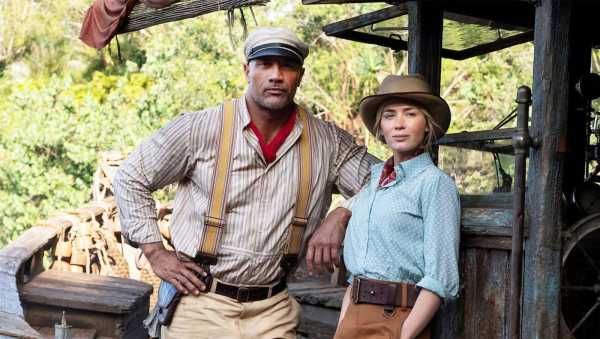
The Disney movie “Jungle Cruise” highlighted the peculiar lack of eroticism in Johnson’s film roles.Photograph from Disney / Pictorial Press / Alamy
A brown man with all the right parts is deprived of a sexuality: it sounds like a familiar American fable. A nation panicked by sex, swallowed whole by racial anxieties, craves a star who can safely neutralize these tensions on the silver screen. As Caity Weaver put it in a GQ piece titled “Dwayne Johnson for President!,” at a time when culture is as polarizing as politics, he’s “someone it’s safe to like.” The critic Wesley Morris has invoked Johnson as evidence of the lingering fear of Black male sexuality in the movies. “A century after [D. W.] Griffith, you’re free to go to a theater and watch Chris Hemsworth throw his legs open and parade his fictional endowment, while sparing a thought for what it would mean if a black star who goes by the Rock were to do the same.” It’s true that our age of Black-led blockbusters has plenty in common with Hollywood’s history of siloing Black actors into palatable types. And yet Mandingo panic cannot fully explain Johnson’s onscreen chastity, because his Blackness in the movies is rarely a given. On the contrary, in role after anodyne role—including his latest, in the DC Comics blockbuster “Black Adam”—Johnson slips in and out of racial categories at will. The only fixed aspect of his onscreen presence is his own singular stardom.
Born in Northern California, in 1972, Johnson had a peripatetic childhood, but he often speaks of Hawaii as the place that made him. His father, Rocky, was a professional wrestler from Nova Scotia. His mother, Ata, was the daughter of parents who were both pillars of the wrestling business. High Chief Peter Maivia, a champion wrestler in both New Zealand and the United States, and his wife, Lia Maivia, a steely promoter within the Hawaii territory, did not approve of Rocky as their daughter’s mate. “Now, you might think this had something to do with the fact that Rocky is African American,” Johnson writes in his 2000 memoir, “The Rock Says…” “But it didn’t. Hell, Samoans are people of color, too.” The Maivias, having seen the “demons” of the showman life style, simply did not wish to see their child pair off with a wrestler.
Rocky and Ata eloped and travelled frequently for Rocky’s matches, usually within the South. But when Johnson was eight they made a home on Oahu and were enfolded back into the Maivia wrestling clan. One scratchy photo from the time shows a young Johnson seated on the bicep of Andre the Giant. A Polynesian wrestler and friend of the High Chief lent Johnson the trunks for his first proper match in Corpus Christi, in 1996. In his memoir, Johnson narrates his youth in height-weight stats, as in a gym diary. At thirteen—a hundred and seventy pounds, and more than six feet—his teen’s body was being received as a man’s. Johnson presents his burgeoning mass as inextricable from his dawning sexuality. “When it came to fighting or fornicating, I was way ahead of the curve,” he writes, explaining that he lost his virginity at fourteen to a Hawaiian girl four years his senior. On getting into fights, he writes, “Not only did I attract the attention of older women, I also seemed to get a rise out of men. Older boys, actually…. I was bigger, stronger, and more confident.”
Johnson has been open about his fraught relationship with his father, saying, “My dad loved me with the small capability he was capable of.” In a profile last year in Vanity Fair, Johnson described a fierce argument with his father over a memoir Rocky had published shortly before his death, in early 2020. The book boasted a foreword allegedly written by Johnson, crediting Rocky for “everything I’ve done in wrestling, the movies, TV shows and overall business opportunities.” Johnson hadn’t written those words. On “Young Rock,” Johnson’s autobiographical sitcom on NBC, the character of Rocky (Joseph Lee Anderson) carries a whiff of danger, and we see him break promises to his family. The mandates of situational comedy soften the father’s edges. Smiling and vibrant and jacked, he is portrayed through a child’s eyes. Still, the show foments a strange tension between the Rocky of the past and the Rock of the present, juxtaposing the charisma of an elegiac father figure with that of the superstar the son will become.
In the première of “Young Rock,” the Johnson character describes how his father taught him the wisdom of “working the gimmick,” a wrestling term for one’s persona in the ring. In honing his own gimmick, Johnson followed in his father’s footsteps. Professional wrestling in Rocky’s day ran on fixed types. If you were tall or bearded or Italian or backwater or fat or brown and not from here, you costumed yourself accordingly and leaned into the bit. But Johnson writes in his memoir that his father resisted becoming a “jive-talking caricature.” In a Season 2 episode of “Young Rock,” a teenaged Johnson watches Rocky turn down a well-paying gig in hard times rather than shoot a promo with watermelon and a plate of fried chicken. “Promise me one thing,” the father says to his son. Whether or not that scenario really occurred, Johnson got the message. “I’ve never stopped working the gimmick,” he says on the show. I’ve just made the gimmick work for me.”
Racial identity on the Hawaiian Islands follows its own rules. In a place that has seen occupation but never the Old South, Blackness winks in and out of relevance. The scholar Nitasha Sharma wrote in a recent ethnography that figures such as Janet Mock, born in Honolulu, “are often read nationally as Black, but locally as multiracial.” Someone like the Rock can still be “hailed for being a ‘native son.’ ” (To an extent, at least: in 2018, some Native Hawaiians were dismayed by the news that Johnson would star in a biopic of the Hawaiian king Kamehameha.) On an “S.N.L.” sketch called “The Rock Obama,” Johnson played the alter ego of the other, more famous Black child of the Islands. The conceit—what if Obama lost his cool?—was a hybrid of “The Hulk” and “Key & Peele” ’s popular sketch about Obama’s “anger translator.” But whereas Keegan-Michael Key’s portrayal derived its comedy from the fluency of his Black vernacular speech—what if Obama acted Black?—Johnson just did anger oafishly. The character was not a hothead but a himbo, a Presidential lunkhead. His passable Obama impression was wasted on such halting lines as, “Is interesting point but me no like,” and any racial frisson in the premise is wasted. The Rock Obama was more Tarzan than ape.
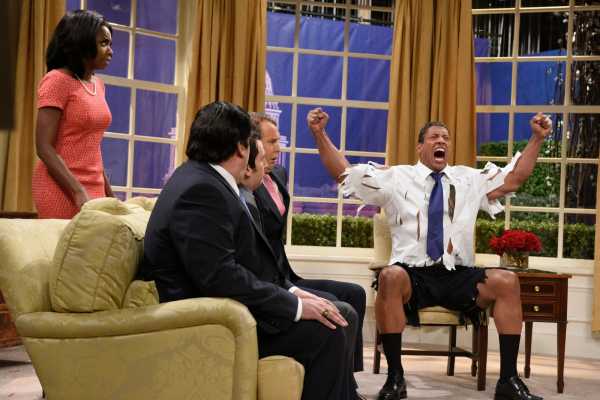
In the S.N.L sketch “The Rock Obama,” Johnson plays another famous Black son of Hawaii.Photograph by Dana Edelson / NBC / Getty
There’s a running joke online that Johnson is always starring in the same film. “These are four separate movies,” one observer notes, sharing a grid of four stills that show Johnson clothed in either gray athleisure or a tan safari shirt open past the throat, standing against a variety of verdant tropical settings. The body always maintains its muscled shape and tone. The scalp is always buzzed to a gleaming smoothness. (“I’m not bald because I went bald,” Johnson has said. “I'm bald because my hair is a cross between an Afro and hair from a llama’s ball sac.”) The point is that the Rock is a star whose chief virtue is constancy. In his filmography, the hero’s love interests are chaste or die offscreen. Sex is some adolescent joke, and children are immaculately conceived. The arc of the HBO sports dramedy “Ballers” is, to me, emblematic of his Hollywood trajectory. In the first season, from 2015, viewers were treated to a shot of Johnson’s character, Spence, mid-screw, bare backside and all. Not long thereafter, the lucky woman was spirited away by the forces of plot, and over the following four seasons the show continued to find convenient reasons to disappear Spence’s girlfriends. By the end of the finale, he is the first Black majority owner in the N.F.L. Owing to a mysteriously declining sperm count, he may also be impotent.
The “Baywatch” remake, from 2017, was something of an outlier. As a bronzed and vulgar-mouthed lieutenant lifeguard, Johnson exuded virility. As a friend of mine put it, he “topped the fuck out of Zac Efron,” metaphorically speaking. But other roles from the decade—many of them made by Johnson’s production company, Seven Bucks–were both consistently prudish and racially all over the place. He played an all-American first responder with a white wife and daughter (“San Andreas”) and a Nigerian primatologist (“Rampage”). In the “Fast and Furious” franchise he was straight out of Samoa, joining a cast that had its fair share of all-American Negroes to balance out the frame.
Johnson was recruited into the “Fast” Fam by another light-skinned action hero, Vin Diesel, but the two men famously do not get along. The beef between them is telling. Diesel, who has called himself “Hollywood’s first multicultural megastar,” clearly feels that he’s owed some credit for Johnson’s success. “I’ve protected Dwayne more than he knows,” he has said. Unlike Johnson, Diesel has been deliberately coy about his racial identity offscreen. (“Is he Black or not? Vin Diesel won’t say,” a 2002 issue of Ebony teased—while nonetheless including him among its “57 Most Intriguing Blacks.”) In a nineties short film that he wrote and directed, called “Multi-Facial,” Diesel plays Mike, an actor on the audition circuit, struggling to fit in among Hollywood’s rigid racial codes. His ambiguous appearance allows him to audition for a wide variety of roles—Italian American, Latino, Black American—but prevents him from landing any of them. “I could read you but you’re really too light,” he’s told at one audition. In a prepared monologue, Mike tells a story about watching his father, also an actor, play Walter Lee in a production of “A Raisin in the Sun”: “My dad was a Black actor. But he wanted me to go one step further. He wanted me to be an actor. Just an actor.”
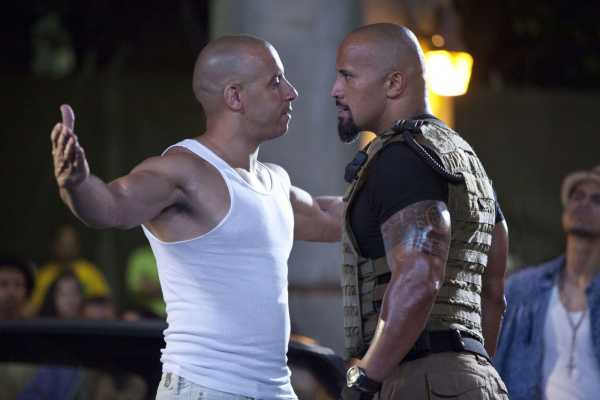
Vin Diesel and Johnson face off in a scene from “Fast Five.” The rivalry extends offscreen.Album / Alamy Stock Photo
You can see how Johnson would rankle. Diesel’s standout credits of the past decade have been restricted to the “Fast and Furious” series and a voice-acting role for Marvel, while Johnson has put his brown skin to work as the “Multi-Facial” protagonist only dreamed of (and, it should be noted, as a light-skin Black actress almost certainly couldn’t). Maybe it’s Diesel’s voice, which is indecently deep, with the texture of crushed velvet. Maybe it’s his face, which is too workmanlike to ever count as tentpole pretty. Meanwhile, the babyfaced Johnson was praised in Ebony for managing to “uphold and celebrate his Black and Samoan heritages equally,” and has proved himself apt at playing both and neither. Toward the end of “Fast Five,” Johnson and Diesel face off in a warehouse. We’re to understand them as equals, or foils, two men alike in complexion and grooming, on opposing missions who, as plot would have it, end up sharing a common goal. Diesel’s character wins the fight, but Johnson won the war.
Johnson’s performances have a way of throwing the Blackness of his fellow Black stars into relief. In Michael Bay’s heist movie “Pain & Gain” (2013), he got the relatively meaty part as an evangelical ex-con while his darker skinned costar, Anthony Mackie, was left to play the minstrel—“the big black man in tears,” as one character puts it. (The reason he cries: steroid-induced shrinkage.) His frequent team-ups with Kevin Hart, charming as they are, work in part because Hart is willing to embrace the kind of racialized gimmick that Johnson rejects. There is a scene in “Jumanji: Welcome to the Jungle” (2017) that is orchestrated for a bit of dick humor: three in-game avatars, played by Johnson, Jack Black, and Kevin Hart, stand pissing side by side. “I’m happy to report I was able to bring in one thing from the outside world,” Hart jokes, pleased with his virtual member. Black’s character tries to sneak a peek. Johnson’s, standing in the middle, is the only one who makes no mention of his own Johnson. He’s primarily concerned with aim.
I’m not opposed to Wesley Morris’s theory that Johnson’s sexlessness can be understood as a punitive byproduct of his Blackness. But what if it was all according to plan? Johnson has leveraged the elasticity of his racial identity to free himself from sexual baggage. He has sacrificed his natural intrigue and virtuosity at the altar of bankability.
There are signs, in his early films, of the stranger star who could have been. I am thinking, for instance, of “Be Cool” (2005), the sequel to “Get Shorty,” in which Johnson plays Elliot, a gay bodyguard for a thug-life wannabe played by Vince Vaughn. When I watch the movie I’m reminded that Johnson’s face and body used to really move. There was the People’s Eyebrow, yes, but also the People’s hips and torso. The character of Elliot is also an aspiring actor, and (through some plot michegoss) he ends up performing a scene from “Bring It On” that takes place between the characters played by Kirsten Dunst and Gabrielle Union. Delivering Union’s lines, Johnson’s entire posture changes: his hand goes on his hip, his fingers snap, his neck rolls, a diamond flashes in his ear. It’s silly but also rather risky—a Black Samoan man playing a “Samoan faggot” playing a mean Black hottie. On YouTube, one commenter declared, “This is the Rock’s greatest achievement in film.”
I’d be inclined to agree if it weren’t for his turn in “Southland Tales,” a knotty 2006 film by the writer-director of “Donnie Darko.” Johnson is Boxer Santaros, who has lost his memory as a consequence of experimental time travel. In his former life he was a movie star (and a Republican), but absent this knowledge he must now improvise his way into a new life. “You can see him trying on the various roles,” the critic Steven Shaviro has written. Twitchy and anxious and perpetually befuddled, Johnson here is very unlike any version of the Rock that fans had known. One of my favorite parts of his performance comes in an early scene with Seann William Scott, who (plot michegoss again) is playing a character trying on the role of a racist cop. “To be honest, we’re just looking for the niggers,” Scott’s character tells Santaros during a ride-along. The comment sets off a chain of facial reactions in Johnson’s character as he tries to determine whether the officer is joking, and comport himself accordingly. Stony one moment and tightly grinning when the camera cuts back a second later, Johnson’s face lends the scene its awkward comedic pulse. It is exhilarating to see the Rock trying to be somebody other than the Rock.
As Black Adam in the DC Extended Universe, Johnson has in theory turned heel again, as in his W.W.F. days. The character is an ancient baddie with an anger problem—technically a supervillain. Johnson has said that DC originally wanted the character slotted into the 2019 film “Shazam!,” a comedy, but that he insisted on going in a darker direction. Black Adam has been sold as a departure from the unimpeachable version of Johnson we know, and a harkening back to his own grittier origins. “Superman was the hero I could never be,” Johnson has said, recalling his rebellious youth. He’s boasted that Black Adam has no problem killing people, and the producers have advertised that the film barely secured its PG-13 rating. The spin seems to have paid off, commercially at least—“Black Adam” is Johnson’s best solo opening to date.
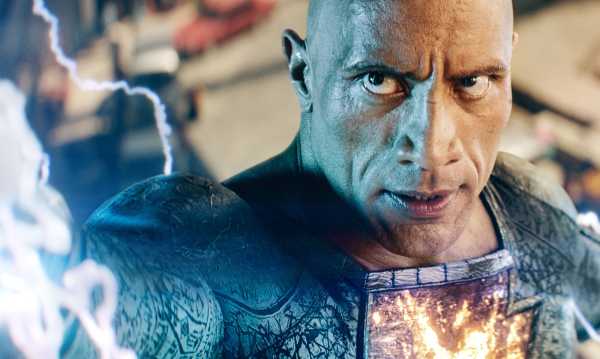
Johnson has said, of his role as the DC supervillain Black Adam, “Superman was the hero I could never be.”Photograph courtesy Warner Bros. Pictures
The color in the film’s title does not refer to race—not exactly. “The Black in Black Adam refers to his soul,” Johnson recently told Vanity Fair. The character, originally known as Teth-Adam, was born a slave in the fictional Middle East civilization of Kahndaq and was gifted with superpowers after rebelling against his enslavers. In the film’s present day, he has been summoned to save modern-day Kahndaq from colonial occupation (a thinly veiled allusion to Palestine). The role leaves little room even for the Rock’s signature charm. Adam speaks either in the fictional native tongue of Kahndaq or in halting English. A thickly built sentinel, he travels at warp speed and destroys indiscriminately. (The soundtrack to his first rampage: the Rolling Stones’ “Paint It, Black.”) Despite its subject matter, the film goes out of its way to disentangle itself from racial politics, assembling an equally diverse cast of do-gooders and antagonists. Yet there is an unwitting meta-comedy in the film’s insistence on only spiritual “darkness.” In a post-credits sequence, Viola Davis (as the DC honcho Amanda Waller) greets Adam in her lippy, trademark enunciation, underscoring—with a bit of annoyance, maybe—his new appellation: “O.K., Black Adam. Congratulations, you have my attention.”
There is a trace of delusion in Johnson’s idea that a superhero movie could herald his return to form. It is not a new observation that contemporary blockbuster franchises are uninterested in the body beyond its capacity as a weapon. “Sexuality doesn’t exist for superheroes–they are neutered,” Pedro Almódovar has said. In a recent interview, James Cameron observed of today’s action heroes, sounding perhaps a bit too high on his horse,“They all act like they’re in college. They have relationships, but they really don’t.” Black Adam was never going to be the role in which Johnson reclaimed his bestial side. There is one moment, though. It happens near the end, and, mindful of spoilers, I’ll just say that Adam is seated. We are looking up at him, as though kneeled at his feet, an unusual angle for films like these, which often care more about what’s going on above the torso than below. Johnson’s body language is a provocation: his legs are spread, casually, like a scumbag royal, his black skin suit stretching and flexing over his ample form. The image is suggestive, a signifier without a referent. What are Adam’s wants? What are his desires? (Does he have any besides revenge?) The film ultimately falls back on the trope of the “antihero,” which is to say that Black Adam’s soul is black but not too black. With the right branding, darkness can be something universal, too. “You may interpret him as a supervillain, antihero, protector, even a superhero,” Johnson said of the film, adding, “You may not agree with his philosophy, but everyone understands.” ♦
Sourse: newyorker.com






